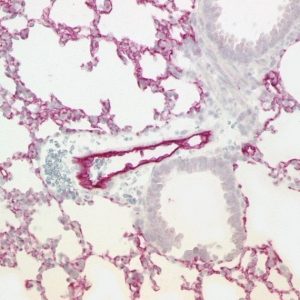Current studies (Hoffmann et al, Cell 181, 2020) demonstrate that SARS-coronavirus 2 (SARS-CoV-2) uses ACE2 (angiotensin-converting enzyme 2) as a specific receptor for binding and subsequent entry into target cells. This specific interaction provides opportunities for research and antiviral intervention.
Cellular attachment of coronavirus depends on the viral spike (S) protein. The S1 unit of the S-protein binds a receptor on target cells. Entry of the virus requires cleavage of the S-protein by cellular enzymes (proteases). This process is called S protein priming and allows fusion of viral and cellular membranes and thus viral entry.

SARS (severe acute respiratory syndrome) emerged 2002 in China. Research studies demonstrated that the infectious agent SARS-CoV uses ACE2 as the receptor for entry into lung cells (Li et al, 2003) and recruits the cellular protease TMPRSS2 for S protein priming (Matsuyama et al., 2010). The interaction of ACE2 with the SARS-S protein is critical for viral transmissibility (Li et al, 2005).
Covid-19 (coronavirus disease 19) emerged 2019 in China. This new infectious respiratory disease is driven by SARS-CoV-2 (SARS-coronavirus 2) which shares high genomic similarities with SARS-CoV. Moreover, both viral S-proteins share approx. 76% of amino acid identity. Now actually, scientists form the German Primate Center, Göttingen and the Instituite of Virology, Charité, Berlin (Hoffmann et al., Cell 181, 2020) reveal important similarities between SARS-CoV-2 and SARS-CoV: ACE2 is the SARS-CoV-2 receptor on host cells. As a prerequisite for entry the virus uses host protease TMPRSS2 for S protein priming. Authors demonstrate that a clinically approved TMPRSS2 inhibitor blocks viral entry and moreover, show that immune sera from convalescent SARS patients neutralize S-driven entry of SARS-coronavirus 2.
These important findings open new windows for preclinical research to elucidate potential treatment options for Covid-19.
 Find antibodies for development of diagnostic test systems. Jackson ImmunoResearch manufactures anti-Human IgG, IgM and IgA antibodies employed in clinical diagnostic testing. The antibodies are currently being utilised for SARS-CoV-2 antibody tests.
Find antibodies for development of diagnostic test systems. Jackson ImmunoResearch manufactures anti-Human IgG, IgM and IgA antibodies employed in clinical diagnostic testing. The antibodies are currently being utilised for SARS-CoV-2 antibody tests.
For specific s election of our antibody products we love to support you personally. Please contact our scientific support team.
election of our antibody products we love to support you personally. Please contact our scientific support team.
References
- Hoffmann M. et al., SARS-CoV-2 Cell Entry Depends on ACE2 and TMPRSS2 and Is Blocked by a Clinically Proven Protease Inhibitor. Cell (2020) 181: 1-10, https://doi.org/10.1016/j.cell.2020.02.052
- Matsuyama S. et al., Efficient activation of the severe acute respiratory syndrome coronavirus spike protein by the transmembrane protease TMPRSS2. J. Virol. (2010) 84: 12658-12664
- Li F. et al., Structure of SARS coronavirus spike receptor-binding domain complexed with receptor. Science (2005) 309: 1864-1868
- Li W. et al., Receptor and viral determinants of SARS-coronavirus adaptation to human ACE2. EMBO J. (2005) 24: 1634-1643
- Li W. et al., Angiotensin-converting enzyme 2 is a functional receptor for the SARS coronavirus. Nature (2003) 426: 450-454
 Follow COVID-19 research community at ResearchGate and stay up to date on the latest COVID-19 research. This social networking site for scientists provides updates on the latest COVID-19 research and support.
Follow COVID-19 research community at ResearchGate and stay up to date on the latest COVID-19 research. This social networking site for scientists provides updates on the latest COVID-19 research and support.
